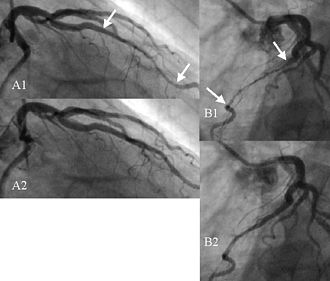- Myocardial bridge
-
A myocardial bridge occurs when one of the coronary arteries tunnels through the myocardium rather than resting on top of it. Typically, the arteries rest on top of the heart muscle and feed blood down into smaller vessels that populate throughout the myocardium. But if the muscle grows around one of the larger arteries, then a myocardial bridge is formed. As the heart squeezes to pump blood, the muscle exerts pressure across the bridge and constricts the artery. This defect is present from birth. It can lead to uncomfortable, powerful heartbeats and angina. The incidence of the condition in the general population is estimated at 5% based on autopsy findings,[1] but significance when found in association with other cardiac conditions is unknown.[2]
The condition is diagnosed on a scaled based on what percentage of obstruction occurs. If there is less than 50% blockage, then the condition is probably benign. A result of at least 70% usually causes some pain. Small amounts of myocardial bridging often are undetectable, as the blood usually flows through the coronary while the heart is relaxing in diastole.
This condition can cause complications such as vasospasm, angina pectoris, arrhythmia, Vtach. Additionally many patients express discomfort in specific positions, (i.e. lying on the left side for a prolonged period of time).
Contents
Case study
Figure 1 shows a series of angiographic images with a bridge on the left anterior descending coronary artery (LAD) in a male patient of 65 years.
- A1) Right anterior oblique view taken at end systole. The compressed vessel segment is indicated by the two arrows.
- B1) Left anterior oblique view taken nearly at the same instant.
- A2) Same view as in A1, but taken 133 ms later. The tunneled segment is no longer compressed.
- B2) Same view as in B1 but 133 ms later.
See also
- Cardiac CT
- Angiography
References
External links
- Harlan Krumholz, M.D. discusses myocardial bridging
- Medical definition of myocardial bridge
- Myocardial bridge summary by the Texas Heart Institute
Categories:- Heart diseases
- Medicine stubs
Wikimedia Foundation. 2010.

